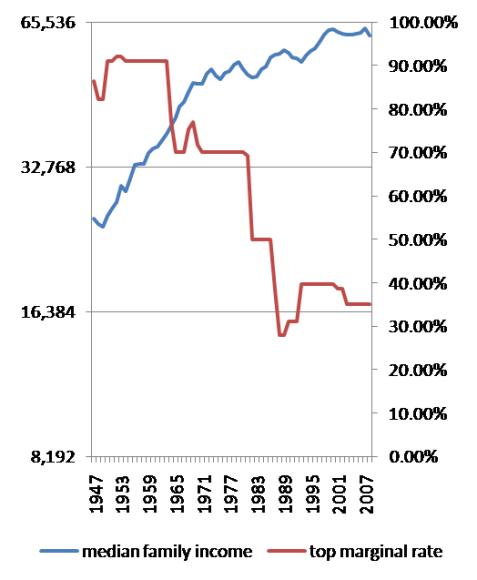This is another great graph by Nobel Prize-winning economist Paul Krugman, from his blog at the New York Times. (Note that I posted about a previous graph here).
The red line is the top marginal income tax rate in America, while the blue line is the median family income. Shown this way, it's pretty easy to see that, as we've slashed taxes on the rich in recent decades, average family incomes have begun to stagnate. The point is not necessarily to show cause-and-effect, but rather to demonstrate the error of right-wing propaganda.
But Paul Krugman puts it better than I could:
Richard Green flies into a rage over remarks by Peter Wallison, who declares that
Indeed, the modern era of rapid economic growth commenced after both Democratic and Republican presidents undertook to lift costly and stultifying New Deal regulations.Green points out that growth has actually been slower since the big rightward shift circa 1980. But what he doesn’t seem to realize is that Wallison is just following the party line. Read almost any conservative commentator on economic history, and you’ll find that the era of postwar prosperity — the gigantic rise in living standards after World War II — has been expunged from the record.
You can see why: the facts are embarrassing. Here’s a rough-cut version. The blue line, left scale, shows median family income in 2008 dollars; the red line, right scale, shows the top marginal tax rate, a rough indicator of the overall stance of policy. Basically, US postwar economic history falls into two parts: an era of high taxes on the rich and extensive regulation, during which living standards experienced extraordinary growth; and an era of low taxes on the rich and deregulation, during which living standards for most Americans rose fitfully at best.
At the Richard Green post, I see that Peter Wallison parrots another Republican Party line, too: "After all, the original New Deal—as anyone who has read history knows—failed to revive the economy." Actually, as anyone who has looked at the historical record knows, the New Deal was exactly the right medicine for the ailing economy. If anything, it was too timidly - too conservatively - applied, but the result was still obvious.
Franklin D. Roosevelt's biggest error was to listen to right-wing fears and attempt to balance the budget before the economy was completely healthy again, which led to another sharp downturn in 1937. The evidence is also clear on that. You really couldn't ask for a better demonstration of what worked and what didn't.
The right-wing, which fought against every bit of the New Deal, now claims that it was a complete failure because they realize that most Americans won't know any better. They claim that the economy didn't fully recover until World War II, which might actually make some sense (if you remember the reason for the dip in 1937). But what was World War II in economic terms but massive government stimulus? And note that it began in the U.S. before we were actually in the war ourselves.
There's good reason why deficit spending has been the standard prescription for economic downturns since the Great Depression. Quite simply, the evidence of its value has been overwhelming. Where it hasn't worked - such as in Japan's Lost Decade - that's because it was applied slowly, meagerly, hesitantly. Dribbling out government stimulus does nothing but increase deficits. Governments need to be bold. Unfortunately, governments are made up of politicians, and politicians are notoriously timid.
Well, bold politicians don't get re-elected. And as we're seeing today, it's easy to scare the average uninformed voter. After all, even a laughable claim like "death panels" worked politically. I guess, as a people, we're just not too bright.






No comments:
Post a Comment